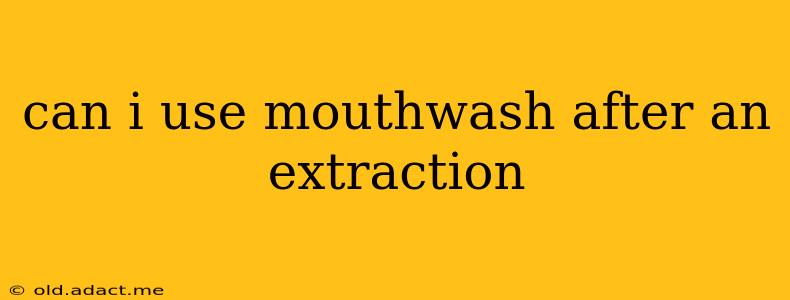Can I Use Mouthwash After an Extraction?
The short answer is: generally no, not immediately after a tooth extraction. While mouthwash is a regular part of good oral hygiene, using it too soon after an extraction can significantly hinder the healing process and even lead to complications. This is because the extraction site is a fresh wound, and certain ingredients in mouthwash can interfere with blood clot formation and healing.
Let's delve into the specifics and answer some frequently asked questions surrounding mouthwash use post-extraction.
What Happens Immediately After a Tooth Extraction?
After a tooth extraction, a blood clot forms in the socket where the tooth was removed. This clot is crucial for preventing infection and promoting healing. The process of clot formation takes several days, and disrupting it can lead to a painful and serious complication called "dry socket."
What Ingredients in Mouthwash are Harmful After Extraction?
Many mouthwashes contain ingredients that can dissolve the blood clot or irritate the sensitive extraction site. These include:
- Alcohol: Alcohol is a common ingredient in many mouthwashes and can dry out the socket, making it more susceptible to infection and delaying healing.
- Hydrogen Peroxide: While hydrogen peroxide has antiseptic properties, it can also disrupt clot formation and irritate the wound.
- Chlorhexidine: Although sometimes prescribed by dentists for specific post-operative care, chlorhexidine can also be harsh on the extraction site, especially in the initial healing stages. It should only be used as directed by a dental professional.
When Can I Use Mouthwash After a Tooth Extraction?
Your dentist will provide specific instructions, but generally, it's recommended to wait at least 24-48 hours before using any mouthwash after an extraction. Even then, you should choose an alcohol-free, gentle mouthwash and use it cautiously. Rinsing should be gentle to avoid dislodging the clot.
What Should I Do Instead of Using Mouthwash After an Extraction?
In the initial days following an extraction, focus on gentle cleaning techniques to maintain oral hygiene:
- Saltwater Rinse: A warm saltwater rinse (1/2 teaspoon of salt dissolved in 8 ounces of warm water) is often recommended. This helps to clean the area gently and reduce swelling. Rinse gently several times a day.
- Soft-Bristled Toothbrush: Use a soft-bristled toothbrush and avoid brushing directly over the extraction site for the first few days.
- Follow Your Dentist's Instructions: Your dentist's post-operative instructions are paramount. Follow them diligently for optimal healing.
What are the signs of a dry socket?
A dry socket is a painful complication that can occur if the blood clot is dislodged from the extraction site. Symptoms include:
- Severe pain, often radiating to the ear or jaw
- A bad taste or odor in your mouth
- A visible empty socket
If you experience any of these symptoms, contact your dentist immediately.
Can I use mouthwash to prevent infection after an extraction?
While mouthwash can help with general oral hygiene, it's not a primary method for infection prevention after an extraction. The best way to prevent infection is to follow your dentist's instructions meticulously, maintain good oral hygiene with gentle techniques, and attend any follow-up appointments.
Disclaimer: This information is for educational purposes only and does not constitute medical advice. Always consult your dentist or oral surgeon for personalized guidance following a tooth extraction. They can assess your individual needs and recommend the most appropriate aftercare plan.
